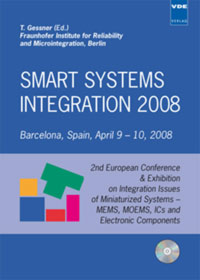Thermal mass flow sensor for measurement of liquids (water)
Conference: Smart Systems Integration 2008 - 2nd European Conference & Exhibition on Integration Issues of Miniaturized Systems - MOMS, MOEMS, ICS and Electronic Components
04/09/2008 - 04/10/2008 at Barcelona, Spain
Proceedings: Smart Systems Integration 2008
Pages: 3Language: englishTyp: PDF
Personal VDE Members are entitled to a 10% discount on this title
Authors:
Lange, Peter (Fraunhofer Institut für Siliziumtechnologie, Mikrosystemtechnik, Itzehoe, Germany)
Melani, Massimiliano; Bertini, Lorenzo; Marinis, Marco De (SensorDynamics AG, Navacchio (Pisa), Italy)
Abstract:
In water distribution facilities a large fraction of fresh water never actually reaches the consumer, but pours out of holes in the supply pipes and seeps unused into the ground. A new, cost-efficient sensor currently being tested in Pisa, Italy, has been designed to locate these leaks. The wellknown principle of hot wire anemometry has been combined with calorimetric principles for mass flow measurements in fluids. At the heart of the sensor are two heating wires, which are mounted one behind the other on a thin membrane. An electric current flowing through the wires heats them to a constant temperature. When cold water flows past them, the front wire gives off more heat into the water than the rear one, which is in its slipstream. Accordingly, a higher current has to flow through the front wire in order to keep the temperature constant. From the current the speed and volume of the water traveling through the pipes can be calculated. On the basis of the difference in electrical current, it is possible to determine the directionality of the flow. The current I (or voltage U) which is needed for constant temperature measurement, is proportional to the mass flow. However, there are deviations from a linear dependence according to the "Kings Law". The King’s law takes account for the different contributions to the heat transfer through the boundary layer by convection and conduction with flow and is emperically described as I2Rw2 = U2 = (Tw - Tref)(A + B · v(exp n). The voltage drop (U) is used as a measure of velocity (v). The constants A, B and the exponent n are emperically detiremined and ambient specific. This nonlinearity must be compensated by a special signal conditioning.


